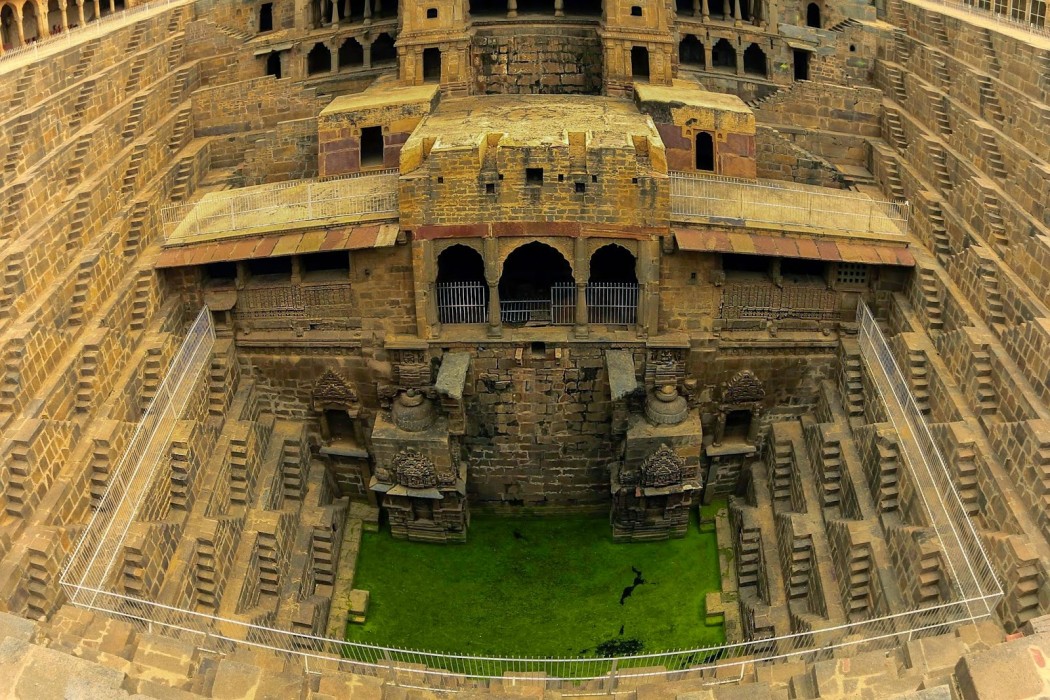Stepwells have been the result of creativity and precision. As the name suggests, they were built to serve as huge wells but soon turned into cool havens for prayer, meditation and leisure. Also known as ‘vav’ or ‘baori,’ they soon came to be called ‘retreat wells.’
The Indus Valley Civilisation was well ahead of its times. It designed what we call the ‘predecessor of the stepwell’ which was developed into our present-day tourist attractions. An architectural marvel, the ancient Indian stepwell gradually narrows from the surface, with hundreds of steps leading to surprisingly cool temperatures and temperaments, almost like a stairwell to heaven. They have little presence above the ground, creating a sort of reverse architecture. The plain walls on the surface are actually holding elaborate works of art hostage! Surprise encounters with these structures embellished with intricate carvings and detailed sculptures leave visitors dumbfounded. Delicate curves embedded into walls, figures telling stories of the past and the perfect right angles create a visual treat.
Let’s take a look at six of our favourite, most creative stepwells in India!
1. Mahila Bag Jhalra, Jodhpur, Rajasthan
Situated where most needed, this one is our favourite simply for its aesthetic appeal. Within the dry region of the country, this stepwell peacefully sleeps unless woken up by the occasional pilgrim or tourist. Light and shadow teasingly dance about one another, dodging and mingling. Even the otherwise unwelcome weeds seem to have made a home for themselves, complementing the fading pink of the walls. This particular relic of the past has somehow managed to adapt to the twenty-first-century-way of things. Its creative appeal stimulates the stunted and transports us back to a ‘golden past’ within shades of, well, many other colours.
2. Rani ki Vav, Patan, Gujarat
Rani Ki Vav, literally meaning ‘Queen’s stepwell’, was commissioned by Queen Udayamati to commemorate her deceased spouse. Water is sacred in the Vedas. Stepwells were the perfect backdrop to the religious sentiments of all castes, creeds and genders. The task of collecting water for daily chores was bestowed upon the women and for this reason stepwells became the go-to place for those who often just wanted relief from monotony. Women treated this space of art and water, both sacred to the Hindus, as a safe sanctuary, which they could visit seeking leisure and relaxation from daily labour. Many women like Queen Udayamati also came to be looked up to as philanthropists because of the religious merit attached to this man-made chasm. She set a great example for the young female dreamer who saw the loopholes in Patriarchy.
3. Chand Baori, Abhaneri, Rajasthan
In a small village near Jaipur, Chand Baori exists, abandoned but not alone. It has evolved into a fairly popular tourist attraction, perhaps because of its scale with 3,500 steps over 13 stories into the ground- that is 100 feet my friends! Its carefully constructed smaller structures were used by the royals of the village around 800 AD for hanging out when it was too hot. ‘Baori(s)’ or stepwells were interestingly free spaces in terms of caste-based segregation, with the exception of the lowest Hindu caste which is still pretty damn progressive for the 8th Century. Built across from the temple of Hashat Mata, Goddess of joy and happiness, Chand Baori holds heavy religious sentiment even today.
4. Rudabai Vav, Adalaj, Gujarat
Another ‘vav’ that was commissioned by a female patron, this beauty is a five stories deep octagonal subterranean pool. What makes this one special is that it was the offspring of two different cultures’ fusion. Around the twelfth century, Mughal rulers took over the control of building these manmade chasms along with the administration. They introduced the ‘true’ dome in place of the customary Indian corbel domes. Hindu artists were now forbidden from carving sculptures and friezes of deities, animals and humans into these familiar structures which were instead adorned with patterned detailing. Rudabai Vav’s conceptual cousin, Dada Harir Vav is just as flamboyant in its design and still exists only nineteen kilometres away from our brilliant offspring.
5. Rajon ki Baoli, Delhi
This is another architectural marvel heavily influenced by the Mughal Empire. It overshadows a nearby mosque both in scale and grandeur. It’s three storeys deep with an additional storey, has a well in the back and a pool in the front. The notable absence of the Hindu touch of deities and humans only gives more to its unique characterisation. One truly realises its scale only once up-front and close, and for a minute there it takes your breath away.
6. Panna Meena ka Kund, Jaipur, Rajasthan
To end with a very Indian, very Rajasthani stepwell, Panna Meena ka Kund was designed by a Brahmin and constructed by craftsmen and engineers. It was famous for being a ‘meeting place’ of sorts because of being in between Jaipur and Amer. Its beauty is no hidden secret, its that kind of obvious beauty that makes you question the current models of cities we live in. Each brick used is as if was meant to live forever. No amount of time can steal away from this one. An interesting tradition people follow here is that nobody steps on the same step twice. Tourists spend hours trying to maintain this tradition while watching the locals glide by.
A space free of social antagonisms and stigmas, stepwells were a refuge to those who were oppressed and those who were bored of oppressing. In spite of all their beauty and heritage, many of these ancient antiquities are tearing apart, victim to decay. Small steps can help preserve these astonishing stories from our past. Visit one before it’s too late!

















